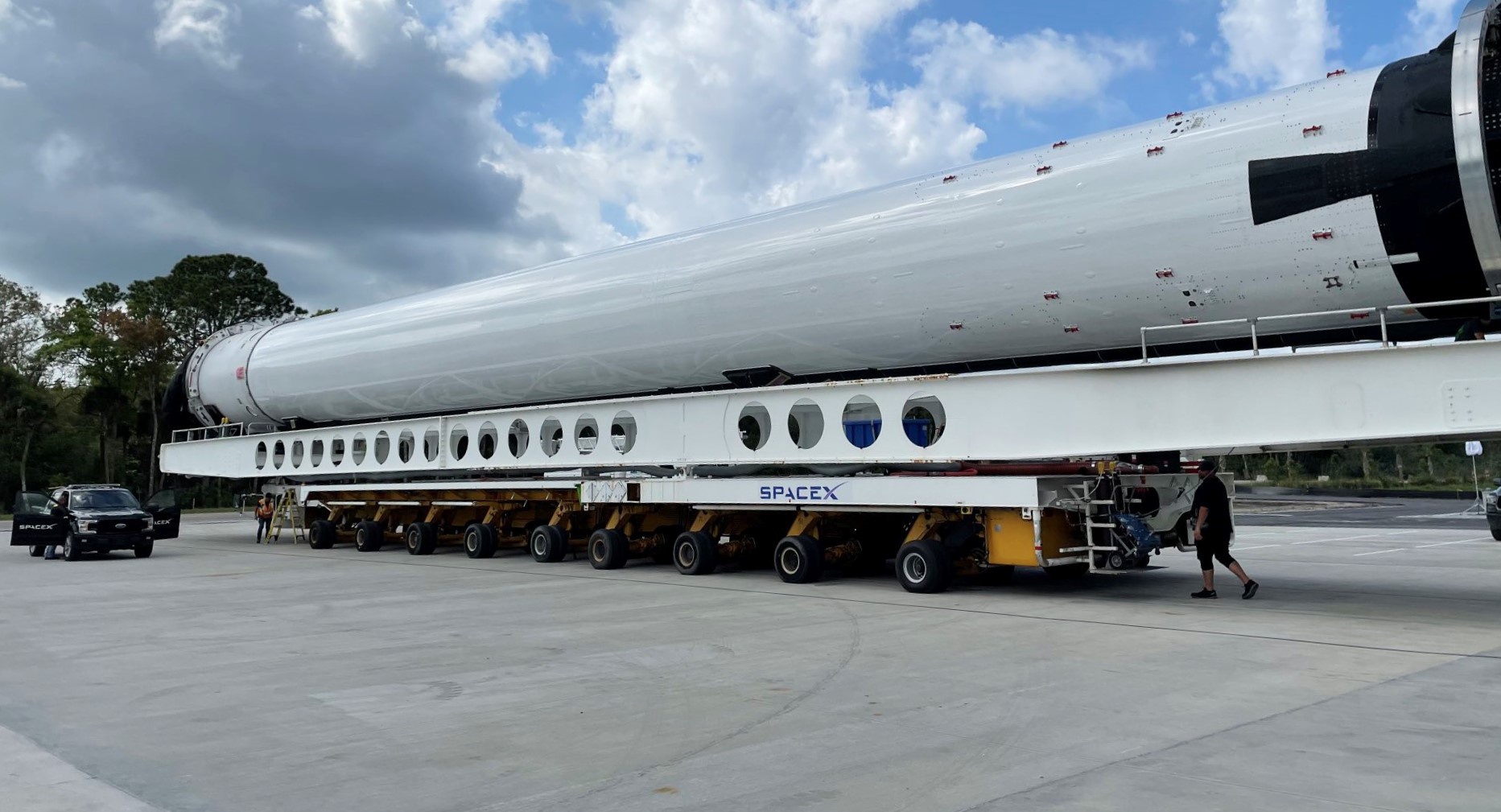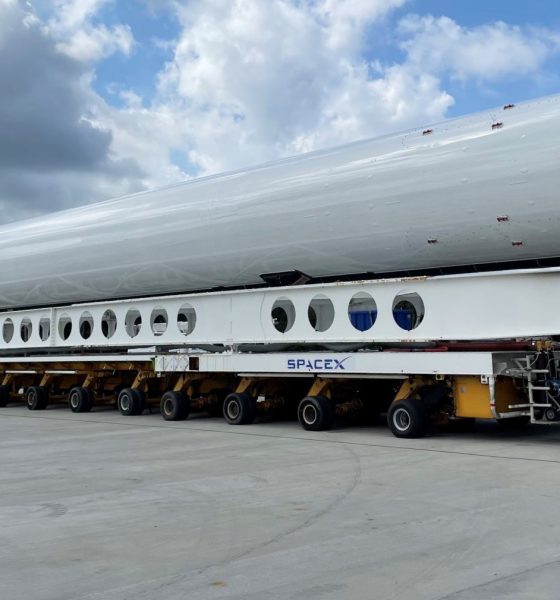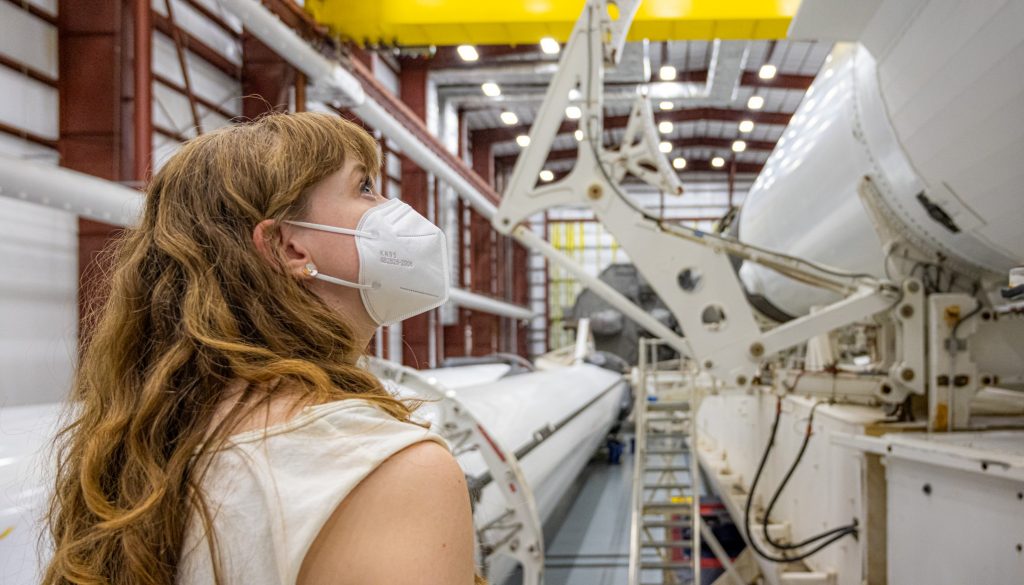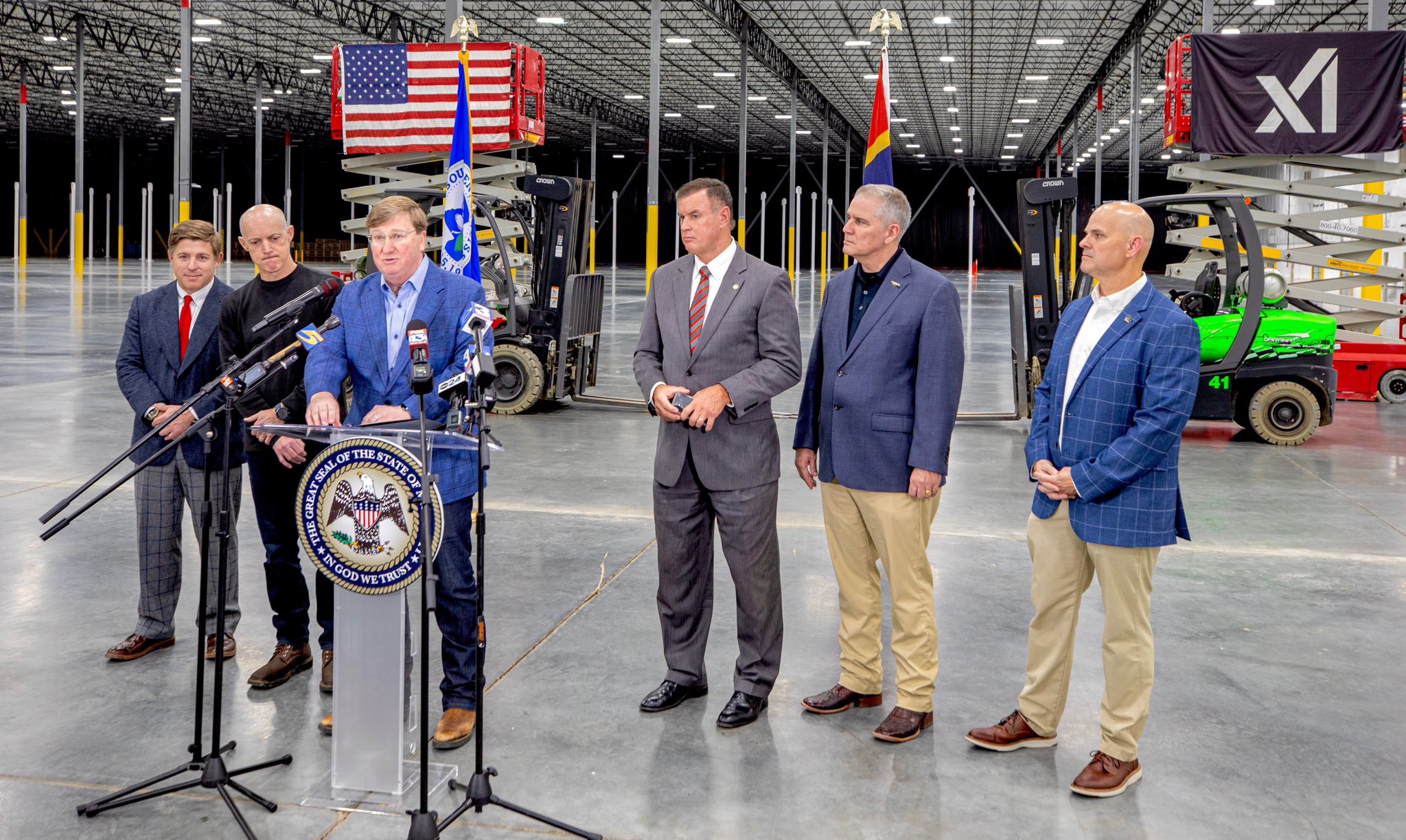

News
SpaceX Falcon Heavy booster spotted at Kennedy Space Center
SpaceX has been spotted transporting a Falcon Heavy booster through NASA’s Kennedy Space Center (KSC) facilities, offering a slight glimpse behind the scenes amid a seemingly unending series of launch delays for the most powerful operational rocket in the world.
Continuing a recent surge of Falcon Heavy booster appearances at or around SpaceX facilities, the latest instance saw the company transporting new, unflown Falcon Heavy center core south through KSC to its HangarX rocket storage and processing facilities. While it does not appear that this particular Falcon Heavy center core is the same core believed to be assigned to the rocket’s next launch, its movement is still significant.
First, it’s not entirely clear where the Falcon Heavy center core came from. SpaceX maintains several fragmented processing and storage facilities in hangars strewn throughout the Cape Canaveral Space Force Station (CCSFS), though SpaceX’s new HangarX facility – located within KSC ground – was presumably meant to organize booster and fairing storage, outfitting, and refurbishment under one roof.
Regardless, the new Falcon Heavy center core moved to HangarX on March 9th, 2022 was missing at least a few essential parts, suggesting that it could merely be headed there to be fully outfitted for an upcoming launch. However, it could also have been moved to HangarX for longer-term storage after waiting too long at a satellite storage facility. Due to seemingly unrelenting delays impacting at least three of several Falcon Heavy launches planned in 2022, SpaceX has been stuck shuffling more and more Falcon Heavy cores over the last six or so months.


As of September 2021, all three new Falcon Heavy cores meant to support USSF-44 – set to be the rocket’s first launch in more than two years – were already inside the integration hangar at Pad 39A, the only launch site able to support Falcon Heavy. Originally meant to launch in late 2020, both USSF-44 and USSF-52 have been more or less indefinitely delayed ever since. In September, USSF-44 – one or several geostationary US military satellites – was expected to launch as early as October 2021. Soon after, the launch was delayed to “early 2022.” As of March 2022, the US military now refuses to offer even a vague public estimate for the mission’s latest launch target.
Combined with a series of either two or three Dragon launches – all of which need Pad 39A – planned as early as late March, mid-April, and early May, it’s now all but guaranteed that Falcon Heavy will have to wait until May or June 2022 for its first launch since June 2019 – a staggering three-year gap. Due to those delays, SpaceX is currently juggling an unprecedented fleet of six (soon to be seven) unflown, ready-for-flight Falcon Heavy boosters on top of another dozen flight-proven Falcon 9 and Heavy boosters.
On top of the military’s USSF-44 and USSF-52 missions, both of which are now years behind schedule, satellite communications provider ViaSat also recently announced the latest in a long line of ViaSat-3 launch delays, pushing its Falcon Heavy launch from this spring to no earlier than “late summer” – i.e. late Q3 2022. Ironically, of Falcon Heavy’s near-term missions, only NASA’s Psyche spacecraft – designed to orbit and explore an exotic asteroid tens to hundreds of millions of miles from Earth – has survived the last year or two without a major launch delay. It remains on track to launch in August 2022.
In fact, given that there is apparently so much uncertainty surrounding USSF-44 and USSF-52 that the US military is no longer willing to offer any public schedule estimate, it’s starting to look likely that Psyche – barring its own delays – could launch before USSF-44, USSF-52, and ViaSat-3. If that’s the case, SpaceX has almost half a year to prepare for the launch and it would only make sense to move all Falcon Heavy cores to longer-term storage until schedule confidence improves.
Unfortunately, that means that until there are signs of tangible preparations or actual military payloads arriving at Cape Canaveral, it’s very likely that SpaceX will have to wait until August 2022 at the earliest for Falcon Heavy’s first launch in more than three years.

News
Tesla Model Y Standard Long Range RWD launches in Europe
The update was announced by Tesla Europe & Middle East in a post on its official social media account on X.

Tesla has expanded the Model Y lineup in Europe with the introduction of the Standard Long Range RWD variant, which offers an impressive 657 km of WLTP range.
The update was announced by Tesla Europe & Middle East in a post on its official social media account on X.
Model Y Standard Long Range RWD Details
Tesla Europe & Middle East highlighted some of the Model Y Standard Long Range RWD’s most notable specs, from its 657 km of WLTP range to its 2,118 liters of cargo volume. More importantly, Tesla also noted that the newly released variant only consumes 12.7 kWh per 100 km, making it the most efficient Model Y to date.
The Model Y Standard provides a lower entry point for consumers who wish to enter the Tesla ecosystem at the lowest possible price. While the Model 3 Standard is still more affordable, some consumers might prefer the Model Y Standard due to its larger size and crossover form factor. The fact that the Model Y Standard is equipped with Tesla’s AI4 computer also makes it ready for FSD’s eventual rollout to the region.
Top Gear’s Model Y Standard review
Top Gear‘s recent review of the Tesla Model Y Standard highlighted some of the vehicle’s most notable features, such as its impressive real-world range, stellar infotainment system, and spacious interior. As per the publication, the Model Y Standard still retains a lot of what makes Tesla’s vehicles well-rounded, even if it’s been equipped with a simplified interior.
Top Gear compared the Model Y Standard to its rivals in the same segment. “The introduction of the Standard trim brings the Model Y in line with the entry price of most of its closest competition. In fact, it’s actually cheaper than a Peugeot e-3008 and costs £5k less than an entry-level Audi Q4 e-tron. It also makes the Ford Mustang Mach-E look a little short with its higher entry price and worse range,” the publication wrote.
Elon Musk
Elon Musk’s xAI bets $20B on Mississippi with 2GW AI data center project
The project is expected to create hundreds of permanent jobs, dramatically expand xAI’s computing capacity, and further cement the Mid-South as a growing hub for AI infrastructure.

Elon Musk’s xAI plans to pour more than $20 billion into a massive new data center campus in Southaven, Mississippi, marking the largest single economic development project in the state’s history.
The project is expected to create hundreds of permanent jobs, dramatically expand xAI’s computing capacity, and further cement the Mid-South as a growing hub for AI infrastructure.
xAI goes MACROHARDRR in Mississippi
xAI has acquired and is retrofitting an existing facility in Southaven to serve as a new data center, which will be known as “MACROHARDRR.” The site sits near a recently acquired power plant and close to one of xAI’s existing data centers in Tennessee, creating a regional cluster designed to support large-scale AI training and inference.
Once completed, the Southaven facility is expected to push the company’s total computing capacity to nearly 2 GW, placing it among the most powerful AI compute installations globally. The data center is scheduled to begin operations in February 2026.
Gov. Tate Reeves shared his optimism about the project in a press release. “This record-shattering $20 billion investment is an amazing start to what is sure to be another incredible year for economic development in Mississippi. Today, Elon Musk is bringing xAI to DeSoto County, a project that will transform the region and bring amazing opportunities to its residents for generations. This is the largest economic development project in Mississippi’s history,” he said.
xAI’s broader AI ambitions
To secure the investment, the Mississippi Development Authority approved xAI for its Data Center Incentive program, which provides sales and use tax exemptions on eligible computing hardware and software. The City of Southaven and DeSoto County are also supporting the project through fee-in-lieu agreements aimed at accelerating development timelines and reducing upfront costs.
Founded in 2023 by Elon Musk, xAI develops advanced artificial intelligence systems focused on large-scale reasoning and generative applications. Its flagship product, Grok, is integrated with the social media platform X, alongside a growing suite of APIs for image generation, voice, and autonomous agents, including offerings tailored for government use.
Elon Musk highlighted xAi’s growth and momentum in a comment about the matter. “xAI is scaling at an immeasurable pace — we are building our third massive data center in the greater Memphis area. MACROHARDRR pushes our Colossus training compute to ~2GW – by far the most powerful AI system on Earth. This is insane execution speed by xAI and the state of Mississippi. We are grateful to Governor Reeves for his support of building xAI at warp speed,” Musk said.
Elon Musk
Tesla AI Head says future FSD feature has already partially shipped

Tesla’s Head of AI, Ashok Elluswamy, says that something that was expected with version 14.3 of the company’s Full Self-Driving platform has already partially shipped with the current build of version 14.2.
Tesla and CEO Elon Musk have teased on several occasions that reasoning will be a big piece of future Full Self-Driving builds, helping bring forth the “sentient” narrative that the company has pushed for these more advanced FSD versions.
Back in October on the Q3 Earnings Call, Musk said:
“With reasoning, it’s literally going to think about which parking spot to pick. It’ll drop you off at the entrance of the store, then go find a parking spot. It’s going to spot empty spots much better than a human. It’s going to use reasoning to solve things.”
Musk said in the same month:
“By v14.3, your car will feel like it is sentient.”
Amazingly, Tesla Full Self-Driving v14.2.2.2, which is the most recent iteration released, is very close to this sentient feeling. However, there are more things that need to be improved, and logic appears to be in the future plans to help with decision-making in general, alongside other refinements and features.
On Thursday evening, Elluswamy revealed that some of the reasoning features have already been rolled out, confirming that it has been added to navigation route changes during construction, as well as with parking options.
He added that “more and more reasoning will ship in Q1.”
🚨 Tesla’s Ashok Elluswamy reveals Nav decisions when encountering construction and parking options contain “some elements of reasoning”
More uses of reasoning will be shipped later this quarter, a big tidbit of info as we wait v14.3 https://t.co/jty8llgsKM
— TESLARATI (@Teslarati) January 9, 2026
Interestingly, parking improvements were hinted at being added in the initial rollout of v14.2 several months ago. These had not rolled out to vehicles quite yet, as they were listed under the future improvements portion of the release notes, but it appears things have already started to make their way to cars in a limited fashion.
Tesla Full Self-Driving v14.2 – Full Review, the Good and the Bad
As reasoning is more involved in more of the Full Self-Driving suite, it is likely we will see cars make better decisions in terms of routing and navigation, which is a big complaint of many owners (including me).
Additionally, the operation as a whole should be smoother and more comfortable to owners, which is hard to believe considering how good it is already. Nevertheless, there are absolutely improvements that need to be made before Tesla can introduce completely unsupervised FSD.








